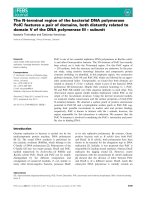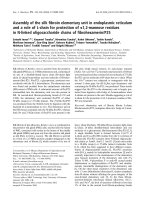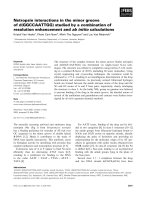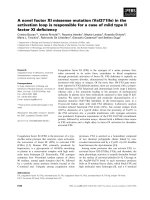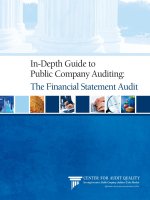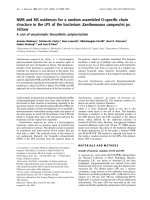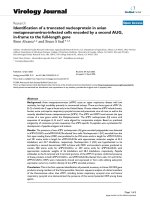Auditing the payable to the supplier in the financial statement audit process by a branch of auditing and informatics service limited company of ho chi minh c
Bạn đang xem bản rút gọn của tài liệu. Xem và tải ngay bản đầy đủ của tài liệu tại đây (22.08 MB, 150 trang )
DUY TAN UNIVERSITY
INTERNATIONAL SCHOOL
UNDERGRADUATE THESIS
AUDITING THE PAYABLE TO THE SUPPLIER IN THE
FINANCIAL STATEMENTS AUDIT PROCESS BY A
BRANCH OF AUDITING AND INFORMATICS SERVICE
LIMITED COMPANY OF HO CHI MINH CITY IN DA
NANG (AISC)
Instructor
: PhD. HO TUAN VU
Student
: NGUYEN THI THANH TUYET
Student code
: 2320250515
Class
: K23PSU KKT1
Da Nang, May 10th 2021
ACKNOWLEDGEMENT
To complete this graduation thesis, I would like to thank sincerely the
teachers of International Education, Duy Tan University for enthusiastically
teaching, equipping the necessary knowledge and helping me go into reality
more confidently. In particular, I would like to express my sincere and deep
thanks to Ho Tuan Vu teacher for enthusiastically instructing and accompanying
me to help me complete this graduation thesis.
Besides, I would also like to thank to the brothers and sisters in Branch of
Auditing and Informatics Service Company Limited in Da Nang created
conditions for me, provided the necessary data to help me complete the
graduation thesis well.
Despite many efforts, my thesis must not avoid certain errors. Therefore,
I hope to receive the sympathy and comments of the teachers so that I can
complete my essay better.
Once again, I sincerely thank you!.
Da Nang, May …, 2021
Student
Nguyen Thi Thanh Tuyet
TABLE OF CONTENT
LIST OF ACRONYMS
LIST OF FIGURES
INTRODUCTION .............................................................................................. 1
CHAPTER 1 THEORETICAL BASIS FOR AUDITING PAYABLE ITEMS
TO SUPPLIER IN AUDITING FINANCIAL STATEMENTS ....................... 3
1.1
OVERVIEW OF PAYABLE TO SUPPLIER ..................................... 3
1.1.1
Contents of the Liabilities to Supplier ........................................... 3
1.1.2
Classification of liabilities to supplier ........................................... 4
1.1.3
Account and accounting rules for Liabilities to supplier ............... 4
1.1.4
Documents relating to Liabilities to supplier................................. 7
1.1.5
Evaluate the impact of supplier's Liabilities .................................. 7
1.1.6
Internal control for supplier's liabilities ......................................... 8
1.2 OVERVIEW OF AUDITING LIABILITIES TO SUPPLIERS IN
AUDITING FINANCIAL STATEMENTS................................................... 9
1.2.1
Role of Auditing Liabilities to Supplier ........................................ 9
1.2.2
Auditing target of Liabilities to Supplier ..................................... 10
1.2.3
Common Mistake Issues with Supplier Liabilities ...................... 11
1.3 AUDIT PROCESS OF LIABILITIES ACCOUNT TO SUPPLIERS .. 12
1.3.1 Audit planning ............................................................................... 13
1.3.2 Audit implementation stage .......................................................... 23
1.3.3 End stage of the audit .................................................................... 28
CHAPTER 2 ACTUAL COMPANY AUDITING PAYABLE ITEMS
SUPPLIER IN AUDITING FINANCIAL STATEMENTS AT BRANCH OF
AUDITING AND INFORMATICS SERVICE COMPANY LIMITED OF HO
CHI MINH CITY IN DA NANG (AISC) ....................................................... 31
2.1 OVERVIEW OF BRANCH OF AUDITING AND INFORMATICS
SERVICE COMPANY LIMITED OF HO CHI MINH CITY IN DA NANG
(AISC) .......................................................................................................... 31
2.1.1 Brief introduction of Branch of Auditing and Informatics Service
Company Limited of Ho Chi Minh City in Da Nang .............................. 31
2.1.2 History and development of Branch of Auditing and Informatics
Service Company Limited of Ho Chi Minh City in Da Nang ................. 32
2.1.3 Characteristics of business activities in Branch of Auditing and
Informatics Service Company Limited of Ho Chi Minh city in Da Nang
.................................................................................................................. 32
2.1.4 The Management's organization of Branch of Auditing and
Informatics Service Company Limited of Ho Chi Minh City in Da Nang
.................................................................................................................. 34
2.2 THE AUDIT PROCESS OF PAYABLE ITEMS TO THE SUPPLIER
IS PERFORMED BY BRANCH OF AUDITING AND INFORMATICS
SERVICE COMPANY LIMITED OF HO CHI MINH CITY IN DA NANG
...................................................................................................................... 37
2.2.1 Audit planning stage ....................................................................... 37
2.2.2 Audit implementation stage ............................................................ 60
2.2.3 End stage of the audit ...................................................................... 67
CHAPTER 3 SOME SOLUTIONS ABOUT THE AUDITING PROCESS ON
LIABILITIES TO SUPPLIERS IN AUDITING FINANCIAL STATEMENTS
AT BRANCH OF AUDITING AND INFORMATICS SERVICE COMPANY
LIMITED OF HO CHI MINH CITY IN DA NANG ...................................... 70
3.1 COMMENTS ON THE AUDITING OF LIABILITIES TO
SUPPLIERS AT BRANCH OF AUDITING AND INFORMATICS
SERVICE COMPANY LIMITED OF HO CHI MINH CITY IN DA NANG
...................................................................................................................... 70
3.1.1 Advantages ...................................................................................... 70
3.1.2 Disadvantages ................................................................................. 73
3.2 SOME SOLUTIONS TO COMPLETE THE AUDIT PROCESS OF
LIABILITIES ACCOUNTS SUPPLIERS AT ABC COMPANY BY AISC
COMPANY .................................................................................................. 73
CONCLUDE .................................................................................................... 77
LIST OF REFERENCES
LIST OF ACRONYMS
TT
AISC
CMKiTVN
Circulars
Auditing and Informatic services company limited
Vietnamese Auditing Standards
LIST OF FIGURES
Figures
Page
Figure 1.1 Auditing process of financial statements according to the
12
audit model program
Figure 1.2 Planning and designing audit methods
13
Figure 1.3 Risk matrix detected
19
Figure 2.1 Organizational structure of AISC
32
Figure 2.2 Organizational chart of Da Nang branch
33
INTRODUCTION
1. Reasons for choosing a research topic
In the world, accounting services are considered as one of the services with
high professionalism and great significance in creating a transparent and
efficient business environment. In Vietnam, although auditing activities only
really appeared after the transition of economic mechanism, but due to the
objective requirements of the economy as well as the encouragement of the
state, the audit services industry has developed strongly developed in Vietnam.
Up to now, the number of auditing firms has grown significantly, the
services provided are constantly diversifying. However, financial auditing is
still considered the most important service because the financial statements
made by enterprises are the subject of the concern of many people.
In the operations of the financial statement audit, auditing the Liabilities
item is an important content because it is directly related to the liquidity and
therefore also affects the existence of the company. Therefore, auditing the
Liabilities item is considered an important part for auditing companies.
The Branch of Auditing and Informatics Service Company Limited in Da
Nang is one of the most reputable companies in the audit industry. Through my
internship at the company, I have grasped a lot of practical knowledge related
to auditing of financial statements in general and auditing of Liabilities in
particular. This is the basis for me to complete my thesis with the topic:
“Auditing of Payable Accounts for Providers by Branch of Auditing and
Informatics Service Company Limited in Da Nang (AISC).”
2. Research Objectives
- From research to find out the general theoretical basis as a basis for the
implementation of the process of auditing of Payable Accounts for Providers.
- To actually experience the process of implementing the Payable item to
the Supplier from there as a basis, lessons, and experience in the implementation
of other items during the complete audit.
1
- Thereby, I myself can draw lessons, learn from experience, skills, draw
advantages and disadvantages, propose some solutions to help improve the
process of the Payable Audit to the Supplier…
3. Research methods
- Document research method: studying documents, related decisions such
as Enterprise accounting regime, Model audit program of Vietnam Association
of Auditors practicing (VACPA), Auditing standards, internal control system,
refer to dissertations, research topics on liabilities.
- Comparison method: From the actual research done at ABC customer,
compare the general audit process with Model audit program of Vietnam
Association of Auditors practicing.
- Methods of collecting documents: From the actual implementation of the
audit process at company, you can learn more skills about collecting documents,
reading data, and books.
4. Structures of the study
Chapter 1: Theoretical basis for Auditing Payable items Supplier in
auditing financial statements
Chapter 2: Actual Company Auditing Payable Items Supplier in auditing
financial statements at Branch of Auditing and Informatic Services Company
Limited of Ho Chi Minh City in Da Nang (AISC)
Chapter 3: Some solutions on the process of Auditing Payable Items
Supplier in the audit of financial statements at Branch of Auditing and
Informatic Services Company Limited of Ho Chi Minh city in Da Nang (AISC).
2
CHAPTER 1
THEORETICAL BASIS FOR AUDITING PAYABLE ITEMS TO
SUPPLIER IN AUDITING FINANCIAL STATEMENTS
1.1 OVERVIEW OF PAYABLE TO SUPPLIER
1.1.1 Contents of the Liabilities to Supplier
An enterprise established and put into production and business operation
must ensure a certain amount of capital. Capital can be obtained from many
different sources: From the business itself or mobilized from outside. From
there, the enterprise's capital sources include: Equity and Liabilities. According
to the Vietnamese accounting system, liabilities reflect all debts arising in the
course of production and business activities that enterprises must pay creditors
to their creditors, including loans and receivables, payables to sellers, to the
State, employees and other payables. The rational use between liabilities and
equity helps the company easily expand scale, increase business efficiency.
Besides, it also has two sides, if not used correctly, can be a threat, the risk of
financial loss to the company, especially insolvency. In order to have effective
and correct directions, we need to learn more about Account 331- Supplier
Liabilities
According to Decision No. 165/2002 / QD-BTC of Standard No. 01
(Vietnamese Accounting Standards): “Liabilities define the current obligations
of the enterprise when the enterprise receives an asset, participating in an
undertakes or arises legal obligations.” “Liabilities arising from past
transactions and events, such as purchasing unpaid goods, using unpaid
services, borrowing, goods warranty commitment, commitment to contractual
obligations, must Pay employees, taxes payable, other payables.”
More specifically, the payable Items to Suppliers have a rather important
role in the buying-selling cycle. Because the purchase process and the checkout
process don't happen at the same time. Therefore, this is the most basic and most
common process that directly and indirectly affects the financial situation of a
3
business. Therefore, Auditing the Supplier Payable Item is a necessary item that
must be done and taken care of.
1.1.2 Classification of liabilities to supplier
Liabilities to provider is an item that accounts for a large proportion of the
liabilities. As presented in the balance sheet, liabilities are divided into shortterm liabilities and long-term liabilities. Typically, entities rely on the maturity
to classify liabilities to the Supplier. Specifically:
- Short-term liabilities: Liabilities that the company is obliged to pay for
within one year, one cycle or less from the balance sheet date. Includes due
payables and long-term debts. Normally for small and medium companies, most
of the liabilities are in short-term liabilities. Some short-term liabilities such as
short-term borrowings, short-term internal payables, accrued expenses...
- Long-term liabilities: That have the maturity of more than one year / one
cycle from the balance sheet date. This allows the company to purchase the right
to installments over many years.
More specifically, short-term liabilities are used to finance liquid assets,
while long-term liabilities are for fixed assets and long-term investments
because companies want to maintain a safe level of liabilities ratio.
1.1.3 Account and accounting rules for Liabilities to supplier
Each object for ease of use in accounting is expressed through an
accounting account. In which, Liabilities to supplier are shown through account
331 - Payable to seller. Typically accounts have a Debit or Credit side balance,
such as Category 1 and 2 accounts with a Debit closing balance, and Category
3, 4 has a closing balance on the Credit side. However, Account 331 is one of a
number of special accounts that can have both a Debit and a Credit balance.
Specifically, the account has a Debit balance in case the buyer makes advance
payments to the seller / service provider, and the Credit balance in case the buyer
has not paid for the goods to the supplier or other payables, ...
4
Under the provisions of Clause 2, Article 51, Circular 200 / TT-BTC of
Circular guiding the corporate accounting regime, structure and contents of the
account 331 - Payables to sellers are clearly stated as follows:
Debit side:
-
Amount paid to sellers of materials, goods, service providers,
construction contractors;
-
Advances paid to sellers, suppliers, contractors for construction and
installation but have not received materials, goods, services, volume of
completed construction and installation products handed over;
-
mount of money the seller accepts to sale rebates or services delivered
under the contract;
-
Payment discounts and trade discounts are authorized by the seller to
deduct from the liability to the seller;
-
The value of materials and goods is shortage and of poor quality when
checked and returned to the seller;
-
Revaluation of payables to sellers in foreign currencies (if the foreign
currency rate falls against VND).
Credit side:
- Adjust the difference between the temporarily calculated price is
smaller than the actual price of the received supplies, goods or services, upon
receipt of an invoice or official price announcement;
- Revaluation of payables to sellers in foreign currencies (if the foreign
currency rate increases against VND).
When making the balance sheet, taking the detailed balance of each object
reflected in this account to record two items on the "Assets" side and the " Total
liabilities and owners’ equity " side.
Under Article 50, Circular 200/2014/TT-BTC of Circular guiding the
accounting regime for corporate payables, the accounting principles of
Liabilities are recorded as follows:
5
1. The payable is monitored in detail according to payment terms, original
currency and other factors according to the management needs of the
enterprise…
2. The classification of payables as trade payables, internal payables, and
other payables is implemented according to the principle:
a) Payables to suppliers includes payables arising from transactions of
purchase of goods, services, assets and seller. This includes payables when
importing through the trustee (in the import trust transaction);
b) Internal payables comprise of payables between the superior and the
subordinate which does not have the subsidiary accounting legal status;
c) Other payables include non-commercial payables, not related to the
transaction of purchase, sale or supply of goods and services:
- Payables related to financial expenses, such as: payable interest
payments, dividends and payable profits, accrued financial investment
expenses;
- Payables paid for by a third party; Amounts received by the trustee from
the related parties for the payment specified in the import and export trust
transaction;
- Non-commercial payables such as payables due to borrowings of assets,
repayment of fines, compensation, surplus of assets awaiting resolution and
payable of social insurance, health insurance, unemployment insurance and
non-commercial insurance …
3. When making the financial statements, the accountant shall base on the
remaining term of the payables to classify them as long-term or short-term.
4. When there is evidence that a loss is likely to occur, the accountant must
immediately recognize a liability on the principle of conservatism.
5. The accountant must determine that the accounts payable satisfy the
definition of the monetary items denominated in foreign currencies (detailed in
Account 413 - Exchange rate differences) for re-evaluation at the end of the
period financial statements.
6
1.1.4 Documents relating to Liabilities to supplier
1.1.4.1 Documents
• Economic contract between supplier and enterprise
• Contract of sale, purchase, lease of property; the order
• Purchase invoices and value added tax
• Warehouse receipt, payment slip
• Quotation, minutes and receipt of goods
1.1.4.2 Book system
• Ledger of TK 331
• Detailed book for each supplier
• Minutes of periodic comparison of data between sellers and businesses,
between businesses and banks
• Working papers of auditors for the previous year (if any)
• Diary of purchases
• Balance sheet
• Balance sheet amounts arising.
• Income statement
• Detail book of payment in foreign currency
1.1.5 Evaluate the impact of supplier's Liabilities
Liability errors or frauds can cause materiality to the financial statements
in two aspects as follows:
- Financial situation: important ratios related to the financial situation such
as debt ratio, current liquidity ratio, etc. so when errors occur in recording,
presenting and using Unreasonable coefficients related to liabilities, this can
easily cause users to misinterpret the financial situation of the company.
- Performance results: liabilities have a close relationship with production
costs of the company. If there is an error in recording an unpaid expense, it will
affect the expenses incurred in the period and the liabilities at the end of the
7
period. Therefore, an element that directly or indirectly affects the payable item
leads to an error in the business performance.
1.1.6 Internal control for supplier's liabilities
Internal control is the procedures created and executed by the company by
people, it is not only policies, procedural instructions, standards, models, but
also the way of implementation of all levels in the company to help the internal
control effective and valuable.
The internal audit of NCC liabilities is a major part of the buying-selling
process. Thus, the internal control procedures must be attached to the steps in
the purchase-sale process. Therefore, the auditor should check the following
issues:
- The inventory control department makes a request to buy goods, the
auditor checks the numbering of the vouchers to limit the false, under-recording
or repeated recording of the voucher which is difficult to control.
- The buying department relies on the purchase order form to issue the
order. An order copy is sent to suppliers, the other is sent to the supplies
department, to the warehouse department, and to the accounting department.
- The supplies department at the warehouse checks the quantity, quality,
price, ... then makes a receipt or receipt note.
- Debt accounting department: vouchers must be signed, date-stamped,
numbered continuously for easy control. The procedures are as follows:
+ Check the quantity on the invoice with the receipt and order report.
Procedures to ensure no excess payment for the ordered quantity.
+ Comparing prices between quotes, orders, invoices to ensure no more
payment than the outstanding balance payable to suppliers.
+ The Finance Department before conducting the consideration and
approval of the fund expenditure must ensure to check the reasonableness,
validity and legality of the documents.
+ Must have a detailed book of debt tracking each customer object.
8
- Accounting for payment and cash accounting must be separated to limit
the possibility of embezzlement of assets.
- At the end of each month, the debt accounting must compare the detailed
books with the ledger and then make a detailed summary table. This table is
saved as evidence that the reconciliation procedure was performed.
1.2 OVERVIEW OF AUDITING LIABILITIES TO SUPPLIERS IN
AUDITING FINANCIAL STATEMENTS
1.2.1 Role of Auditing Liabilities to Supplier
Liabilities to Supplier is the funding source of forming the enterprise's
assets. This is an item related to other items in the financial statements such as
inventory, fixed assets, ... Moreover, liabilities to suppliers have an important
role in the purchase and payment cycle, because this item has an impact on
spending. fees incurred in the period, affecting the profit of the unit. In addition,
liabilities to supplier accounts for a large proportion of the total liabilities, an
important item that makes up the capital of the unit. Therefore, liabilities to
suppliers have a direct influence on the financial position and solvency of the
company through analyzing indicators such as liability turnover and abnormal
fluctuations, ... There are errors for the same item that materially affect the
company's financial statements. But for the liabilities to suppliers it is expressed
through the measurement ratios in the analysis of the financial statements.
- Ratios reflecting solvency
+ Current liquidity ratio
+ Quick liquidity ratio
+ Long-term solvency ratio
- The ratios reflect the financial situation
+ Self-financing ratio = Total owner’s equity / Total liabilities and owners’
equity
If the self-financing ratio of the unit is high, the capital mobilization of the
unit will be low, on the contrary, the low self-financing rate proves that the
financial autonomy of the unit is ineffective. The unit are facing a problem such
9
as dependence from external funding sources, this affects the operation of the
unit.
Thus, the item of liabilities payable by suppliers, when assessed in an
untruthful and reasonable manner, will affect other items in the financial
statements, causing the report readers incorrectly understand the financial
situation of the unit. Therefore, it is necessary for an independent side of an
auditing company to check and give opinions, comments and assessments of the
truthfulness and reasonableness of the financial statements in order to increase
the trust and reliability of users of the financial statements. This is the reason
why it is necessary to audit the Liabilities to suppliers in financial statement
auditing.
1.2.2 Auditing target of Liabilities to Supplier
From the role of the auditor in the financial statements, it can be inferred
that the objective of the audit is to collect and evaluate evidence for the auditor
to give an objective opinion on the information to be audited. Specifically,
Supplier's target of liabilities, auditors collect sufficient evidence and
effectiveness to give the most accurate assessment of the financial situation of
the enterprise.
Assertions are designed to help auditors collect audit evidence about the
aspects being checked, including:
• Completeness: debts are recorded and fully reflected in the financial
statements and related books. This is the most interested goal in the audit
process.
• Existence: debts must actually happen, so that nothing can be written off.
Ensure the existence of debt items to pay suppliers.
• Accuracy: Liabilities to suppliers are recorded with the correct amount
in the book, check the addition of arising amounts, balance, book transfer and
financial statements.
• Cut-off: Payables must be recognized in the correct period of the
transaction incurred.
10
• Right and obligation: to collect evidence to prove whether liabilities are
actually the enterprise's obligations on the date of making the balance sheet or
not. Auditors can check the original arising documents, debt reconciliation
records or send confirmation letters.
• Presentation and disclosure: the debt items are classified and presented
in accordance with Vietnam's auditing regulations and standards. Liabilities to
suppliers are recorded and properly accounted for each object in detail. Because
the wrong or mistaken accounting can falsify the nature of the accounting and
presentation on the financial statements.
1.2.3 Common Mistake Issues with Supplier Liabilities
Liabilities to suppliers is one of the common accounts used in many
companies, this is one of the important accounts in the financial statements. So
that the account often has errors going on. Some of the specific errors are listed
below:
• Clearing the wrong debt between subjects (this problem usually occurs
the most errors).
• Mistakes in arithmetic calculation or recording in incomplete, accurate
and reasonable documents.
• Transactions are not recorded in the correct period of the transactions
that occurred, especially transactions occurring around the closing date of the
financial statements.
• Liabilities are declared lower than actual or not fully recognized,
resulting in increased solvency, leading to inadequate calculation of expenses,
deducing profits to be assessed more than actual. Auditors should pay attention
to real, full recognition of supplier’s liabilities.
• Unrealistic liabilities affect financial ratios, especially this is fraudulent
public cash withdrawal.
• Not enough debt reconciliation records at the end of the period.
11
• Payable are misaligned between accounting books and reconciliation
records.
• Failure to receive confirmation letter from suppliers, causing difficulties
for auditors in confirming whether debts actually exist.
• The debts have not been tracked for each supplier, but tracking each
object is a part that makes it difficult to check against.
• Apply incorrect exchange rates for transactions of foreign currency
origin, do not re-evaluate the balance of foreign currency with the exchange rate
of banks normally traded at the end of the accounting period.
• Applying accounting principles, standards and regimes due to not timely
updating.
1.3 AUDIT PROCESS OF LIABILITIES ACCOUNT TO SUPPLIERS
To ensure the effectiveness, economics, and effectiveness of each audit,
and to obtain sufficient and valid audit evidence on which to base the auditor's
conclusions about truthfulness and adequacy. reason of the data on the financial
statements. In general, the audit process is usually done through the three most
basic stages. Include: Audit planning; audit performance and audit closing
stage.
12
CHU TRÌNH KIỂM TỐN
QUẢN LÝ CUỘC KIỂM TỐN
Đánh giá chung về hệ thống
kiểm soát nội bộ và rủi ro
gian lận [A600]
Kiểm tra cơ bản nợ
phải trả [E100-E600]
Kiểm tra cơ bản
nguồn vốn chủ sở hữu
và khoản mục ngoài
bảng CĐKT [F100F400]
Kiểm tra cơ bản báo cáo kết
quả hoạt động kinh doanh
[G100-G700]
Xác định mức trọng yếu
[A700] và phương pháp
chọn mẫu - cỡ mẫu [A800]
Kiểm tra các nội dung khác
[H100-H200]
Tổng hợp kế hoạch kiểm
toán [A900]
Đánh giá lại mức trọng yếu
và phạm vi kiểm toán [A700] [A800]
Tổng hợp kết quả
kiểm tốn [B410]
Phân tích tổng thể
báo cáo tài chính lần
cuối [B420]
Thư giải trình của
Ban Giám đốc và Ban
quản trị [B440-B450]
Báo cáo tài chính và báo cáo
kiểm toán [B300]
Thư quản lý và các tư vấn
khách hàng khác [B200]
PHÙ HỢP VỚI CHUẨN MỰC KẾ TỐN VIỆT NAM
Phân tích sơ bộ báo cáo tài
chính [A500]
Kiểm tra cơ bản tài
sản [D100-D800]
Tổng hợp kết quả kiểm toán & đánh giá chất lượng
Tìm hiểu chính sách kế tốn
và chu trình kinh doanh
quan trọng [A400]
Lập và sốt xét giấy tờ làm việc
Tìm hiểu khách hàng và môi
trường hoạt động [A300]
Kiểm tra cơ bản bảng cân đối kế toán
Kiểm tra kiểm soát nội bộ
[C100-C500]
Lập hợp đồng kiểm tốn và
lựa chọn nhóm kiểm tốn
[A200]
Lập kế hoạch và xác định rủi ro
TUÂN THỦ CHUẨN MỰC KIỂM TOÁN VIỆT NAM
Xem xét chấp nhận khách
hàng và đánh giá rủi ro hợp
đồng [A100]
Tổng hợp, kết luận và lập báo
cáo
Tổng hợp kết quả kiểm toán
Thực hiện kiểm toán
Kế hoạch kiểm toán
Soát xét, phê duyệt và phát
hành báo cáo [B110]
Soát xét việc kiểm soát chất
lượng cuộc kiểm toán
[B120]
XÁC ĐỊNH, ĐÁNH GIÁ VÀ QUẢN LÝ RỦI RO
Figure 1.1 Auditing process of financial statements according to the audit
model program
1.3.1 Audit planning
Audit planning is the first stage that the auditor needs to perform in each
audit to create the legal and other conditions necessary for the audit.
In the Vietnamese Standard on Auditing 300 on “Auditing planning”,
clearly states: “Auditors and audit firms must prepare an audit plan to ensure
that the audit is conducted effectively.” And: “The audit plan must be
appropriately designed to ensure that material aspects of the audit are covered;
detect fraud, risks and potential problems and ensure the audit is completed on
time”. To fulfill the above objective, an audit plan is usually formulated
according to the following five work steps:
13
Prepare for an audit plan
Collecting information about the entity being
audited
Perform preliminary analytical procedures
Preliminary assessment of the internal control
system
Materiality assessment and audit risk
Making audit planning
Figure 1.2: Planning and designing audit methods
1.3.1.1 Prepare for an audit plan
Audit process is started when the auditor receives a client audit request
from a certain company. However, auditing is a highly competitive industry, so
auditors are very cautious in deciding to approve customers so that the risk is
lowest, because this is a highly legal related industry. Therefore, the auditing
company must have a correct view when making a decision.
a) Assessment of auditing ability
Auditors must evaluate whether accepting a new customer or continuing
to audit with the old customer increases the risk of the auditor or harm the
auditing company. To do that, the auditor needs to consider:
14
• The independence of the auditing company
• Integrity of the Board of Directors (Board of Directors) of the business
being audited.
• The client's accounting system must provide sufficient evidence to prove
the economic profession incurred.
For new customers, first of all, the auditor needs to find out the reasons
for the client's audit invitation, to collect information on aspects such as business
areas, financial status, ... Auditors must increase the information needs to be
collected when customers' financial statements will be widely used, especially
for joint stock companies listed on the stock market, companies with a lot of
debt ... need to collect information from data banks, newspapers, specialized
books and newspapers,…
In the case of an entity that already has a predecessor, the auditor should
seek to obtain information that may be useful to the previous auditors, such as
information about the integrity of the managers units, disagreements between
the two parties (if any), reasons why they do not continue to collaborate with
each other, ... Auditors will have to be very cautious in the cases:
+ Customer does not agree to contact with previous auditors.
+ In the past, there were serious disagreements between the two parties,
so the previous auditor's answers were limited and they could not provide the
necessary information.
+ Through the opinion of the predecessor, the auditor has discovered
some unusual and material problems. With the collected information, the
auditor researches and analyzes the entity's financial position, assessing and
making a preliminary estimate of the materiality and potential risks of the
client's business to decide whether to accept an audit or not. If receiving, the
auditor needs to confirm that it will not violate the law and professional ethics.
Auditors should not accept an audit when the independence is not guaranteed or
considered incompetent to serve customers.
15

